Effects of Aggregate Types on the Stress-Strain Behavior of Fiber Reinforced Polymer (FRP)-Confined Lightweight Concrete
Abstract
:1. Introduction
2. Experimental Database
2.1. Existing Test Data for FRP-Confined Lightweight Aggregate Concrete
2.2. The New Test
2.2.1. Materials Properties
2.2.2. Specimens Design
2.2.3. Experimental Setup and Instrumentation
3. Test Results
3.1. Failure Observations
3.2. Experimental Stress-Strain Curves of FRP-Confined FLWAC
4. Discussions
4.1. Hoop Strain Distribution and Effective Hoop Strain Factor
4.2. Lateral to Axial Strain Relationship
4.3. Ultimate Strength Model
4.4. Ultimate Strain Model
5. Stress-Strain Model for FRP-Wrapped FLWAC
5.1. Stress-Strain Relation
5.2. Determination of Parameters E1, f0, E2, and n
6. Evaluation of the Stress-Strain Model
7. Conclusions
Author Contributions
Funding
Acknowledgments
Conflicts of Interest
References
- JGJ12-2006. Technical Specification for Lightweight Aggregate Concrete Structures; China Engineering and Construction Society Press: Beijing, China, 2006. [Google Scholar]
- Zhou, Y.; Liu, X.; Xing, F.; Cui, H.; Sui, L. Axial compressive behavior of FRP-confined lightweight aggregate concrete: An experimental study and stress-strain relation model. Constr. Build. Mater. 2016, 119, 1–15. [Google Scholar] [CrossRef]
- Sohel, K.M.A.; Liew, J.Y.R.; Yan, J.B.; Zhang, M.H.; Chia, K.S. Behavior of steel-concrete-steel sandwich structures with lightweight cement composite and novel shear connectors. Compos. Struct. 2012, 94, 3500–3509. [Google Scholar] [CrossRef] [Green Version]
- Wang, H.T.; Wang, L.C. Experimental study on static and dynamic mechanical properties of steel fiber reinforced lightweight aggregate concrete. Constr. Build. Mater. 2013, 38, 1146–1151. [Google Scholar] [CrossRef]
- Huang, Z.; Liew, J.Y.R.; Xiong, M.; Wang, J. Structural behaviour of double skin composite system using ultra-lightweight cement composite. Constr Build Mater 2015, 86, 51–63. [Google Scholar] [CrossRef]
- Kong, F.; Evans, R.H. Handbook of Structural Concrete; McGraw-Hill: New York, NY, USA, 1983; ISSN 0-07-011573-7. [Google Scholar]
- Lim, J.C.; Ozbakkaloglu, T. Stress-strain model for normal-and light-weight concretes under uniaxial and triaxial compression. Constr. Build. Mater. 2014, 71, 492–509. [Google Scholar] [CrossRef]
- Wang, H.T.; Wu, G.; Pang, Y.Y. Theoretical and numerical study on stress intensity factors for FRP-strengthened steel plates with double-edged cracks. Sensors 2018, 18, 2356. [Google Scholar] [CrossRef] [PubMed]
- Yu, Q.Q.; Wu, Y.F. Fatigue strengthening of cracked steel beams with different configurations and Materials. J. Compos. Constr. 2016, 21, 04016093. [Google Scholar] [CrossRef]
- Zhang, H.; Li, H.; Corbi, I.; Corbi, O.; Wu, G.; Zhao, C.; Cao, T. AFRP influence on parallel bamboo strand lumber beams. Sensors 2018, 18, 2854. [Google Scholar] [CrossRef] [PubMed]
- Yu, Q.Q.; Wu, Y.F. Fatigue durability of cracked steel beams retrofitted with high-strength materials. Constr. Build. Mater. 2017, 155, 1188–1197. [Google Scholar] [CrossRef]
- Luo, M.; Li, W.; Hei, C.; Song, G. Concrete infill monitoring in concrete-filled FRP tubes using a PZT-based ultrasonic time-of-flight method. Sensors 2016, 16, 2083. [Google Scholar] [CrossRef] [PubMed]
- Li, P.; Wu, Y.F.; Zhou, Y.; Xing, F. Cyclic stress-strain model for FRP-confined concrete considering post-peak softening. Compos. Struct. 2018, 201, 902–915. [Google Scholar] [CrossRef]
- Zhou, Y.; Li, M.; Sui, L.; Xing, F. Effect of sulfate attack on the stress–strain relationship of FRP-confined concrete. Constr. Build. Mater. 2016, 110, 235–250. [Google Scholar] [CrossRef]
- Dai, J.G.; Gao, W.Y.; Teng, J.G. Bond-slip model for FRP laminates externally bonded to concrete at elevated temperature. J. Compos. Constr. 2013, 17, 217–228. [Google Scholar] [CrossRef]
- Liu, Z.; Chen, K.; Li, Z.; Jiang, X. Crack monitoring method for an FRP-strengthened steel structure based on an antenna sensor. Sensors 2017, 17, 2394. [Google Scholar] [CrossRef] [PubMed]
- Teng, J.G.; Jiang, T.; Lam, L.; Luo, Y.Z. Refinement of a design-oriented stress–strain model for FRP-confined concrete. J. Compos. Constr. 2009, 13, 269–278. [Google Scholar] [CrossRef]
- Zhang, D.; Gu, X.L.; Yu, Q.Q.; Huang, H.; Wan, B.; Jiang, C. Fully probabilistic analysis of FRP-to-concrete bonded joints considering model uncertainty. Compos. Struct. 2018, 185, 786–806. [Google Scholar] [CrossRef]
- Jiang, C.; Wu, Y.F.; Jiang, J.F. Effect of aggregate size on stress-strain behavior of concrete confined by fiber composites. Compos. Struct. 2017, 168, 851–862. [Google Scholar] [CrossRef]
- Wu, Y.F.; Jiang, C. Effect of load eccentricity on the stress-strain relationship of FRP-confined concrete columns. Compos. Struct. 2013, 98, 228–241. [Google Scholar] [CrossRef]
- Sui, L.; Luo, M.; Yu, K.; Xing, F.; Li, P.; Zhou, Y.; Chen, C. Effect of engineered cementitious composite on the bond behavior between fiber-reinforced polymer and concrete. Compos. Struct. 2018, 184, 775–788. [Google Scholar] [CrossRef]
- Chen, C.; Sui, L.; Xing, F.; Li, D.; Zhou, Y.; Li, P. Predicting bond behavior of HB FRP strengthened concrete structures subjected to different confining effects. Compos. Struct. 2018, 187, 212–225. [Google Scholar] [CrossRef]
- Wu, Y.F.; Jiang, C. Quantification of bond-slip relationship for externally bonded FRP-to-concrete joints. J. Compos. Constr. 2013, 17, 673–686. [Google Scholar] [CrossRef]
- Wang, Z.; Wang, D.; Smith, S.T.; Lu, D. Experimental testing and analytical modeling of CFRP-confined large circular RC columns subjected to cyclic axial compression. Eng. Struct. 2012, 40, 64–74. [Google Scholar] [CrossRef]
- Rousakis, T. Experimental investigation of concrete cylinders confined by carbon FRP sheets, under monotonic and cyclic axial compressive load. Res. Rep. 2001, 44, 1–87. [Google Scholar]
- Dai, J.G.; Bai, Y.L.; Teng, J.G. Behavior and modeling of concrete confined with FRP composites of large deformability. J. Compos. Constr. 2011, 15, 963–973. [Google Scholar] [CrossRef]
- Li, P.; Wu, Y.F.; Gravina, R. Cyclic response of FRP-confined concrete with post-peak strain softening behavior. Constr. Build. Mater. 2016, 123, 814–828. [Google Scholar] [CrossRef]
- Li, P.; Wu, Y.F. Stress-strain behavior of actively and passively confined concrete under cyclic axial load. Compos. Struct. 2016, 149, 369–384. [Google Scholar] [CrossRef]
- Ozbakkaloglu, T.; Lim, J.C. Axial compressive behavior of FRP-confined concrete: Experimental test database and a new design-oriented model. Compos. Part B Eng. 2013, 55, 607–634. [Google Scholar] [CrossRef] [Green Version]
- Zhou, A.; Qin, R.; Feo, L.; Penna, R.; Lau, D. Investigation on interfacial defect criticality of FRP-bonded concrete beams. Compos. Part B Eng. 2017, 113, 80–90. [Google Scholar] [CrossRef]
- Jiang, J.; Xiao, P.; Li, B. A novel triaxial test system for concrete under passive confinement. J. Test. Eval. 2017, 46. [Google Scholar] [CrossRef]
- Bai, Y.L.; Dai, J.G.; Teng, J.G. Buckling of steel reinforcing bars in FRP-confined RC columns: An experimental study. Constr. Build. Mater. 2017, 140, 403–415. [Google Scholar] [CrossRef]
- Liu, Z.; Zhou, C.; Lu, Y.; Yang, X.; Liang, Y.; Zhang, L. Application of FRP bolts in monitoring the internal force of the rocks surrounding a mine-shield tunnel. Sensors 2018, 18, 2763. [Google Scholar] [CrossRef] [PubMed]
- Wu, Y.F.; Cao, Y.G. Effect of load path on behavior of FRP-confined concrete. J. Compos. Constr. 2017, 21. [Google Scholar] [CrossRef]
- Zhou, Y.; Liu, X.; Xing, F.; Li, D.; Wang, Y.; Sui, L. Behavior and modeling of FRP-concrete-steel double-skin tubular columns made of full lightweight aggregate concrete. Constr. Build. Mater. 2017, 139, 52–63. [Google Scholar] [CrossRef]
- Li, P.; Wu, Y.F. Stress-strain model of FRP confined concrete under cyclic loading. Compos. Struct. 2015, 134, 60–71. [Google Scholar] [CrossRef]
- Teng, J.G.; Huang, Y.L.; Lam, L.; Ye, L.P. Theoretical model for fiber-reinforced polymer-confined concrete. J. Compos. Constr. 2007, 11, 201–210. [Google Scholar] [CrossRef]
- Jiang, J.F.; Wu, Y.F. Plasticity-based criterion for confinement design of FRP jacketed concrete columns. Mater. Struct. 2015, 49, 2035–2051. [Google Scholar] [CrossRef]
- Wu, Y.F.; Jiang, J.F. Effective strain of FRP for confined circular concrete columns. Compos. Struct. 2013, 95, 479–491. [Google Scholar] [CrossRef]
- Jiang, J.F.; Wu, Y.F. Identification of material parameters for Drucker–Prager plasticity model for FRP confined circular concrete columns. Int. J. Solids Struct. 2012, 49, 445–456. [Google Scholar] [CrossRef]
- Popov, V.L. Analysis of impact on composite structures with the method of dimensionality reduction. Facta Univ. Ser. Mech. Eng. 2015, 13, 39–46. [Google Scholar]
- Rohwer, K. Models for intralaminar damage and failure of fiber composites—A review. Facta Univ. Ser. Mech. Eng. 2016, 14, 1–19. [Google Scholar]
- Valvano, S.; Carrera, E. Multilayered plate elements with node-dependent kinematics for the analysis of composite and sandwich structures. Facta Univ. Ser. Mech. Eng. 2017, 15, 1–30. [Google Scholar] [CrossRef]
- Li, W.; Kong, Q.; Ho, S.C.M.; Mo, Y.L.; Song, G. Feasibility study of using smart aggregates as embedded acoustic emission sensors for health monitoring of concrete structures. Smart Mater. Struct. 2016, 25, 115031. [Google Scholar] [CrossRef]
- Du, G.; Zhang, J.; Zhang, J.; Song, G. Experimental study on stress monitoring of sand-filled steel tube during impact using piezoceramic smart aggregates. Sensors 2017, 17, 1930. [Google Scholar] [CrossRef] [PubMed]
- Yan, S.; Ma, H.; Li, P.; Song, G.; Wu, J. Development and application of a structural health monitoring system based on wireless smart aggregates. Sensors 2017, 17, 1641. [Google Scholar] [CrossRef] [PubMed]
- Wu, J.; Kong, Q.; Li, W.; Song, G. Interlayer slide detection using piezoceramic smart aggregates based on active sensing approach. IEEE Sens. J. 2017, 17, 6160–6166. [Google Scholar] [CrossRef]
- Kong, Q.; Fan, S.; Mo, Y.L.; Song, G. A novel embeddable spherical smart aggregate for structural health monitoring: Part II. Numerical and experimental verifications. Smart Mater. Struct. 2017, 26, 095051. [Google Scholar] [CrossRef]
- Kong, Q.; Song, G. A comparative study of the very early age cement hydration monitoring using compressive and shear mode smart aggregates. IEEE Sens. J. 2017, 17, 256–260. [Google Scholar] [CrossRef]
- Kong, Q.; Fan, S.; Bai, X.; Mo, Y.L.; Song, G. A novel embeddable spherical smart aggregate for structural health monitoring: Part I. Fabrication and electrical characterization. Smart Mater. Struct. 2017, 26, 095050. [Google Scholar] [CrossRef]
- ASTM D3039/D 3039M. Standard Test Method for Tensile Properties of Polymer Matrix Composite Material. Available online: https://www.astm.org/Standards/D3039 (accessed on 18 October 2018).
- Cao, Y.G.; Jiang, C.; Wu, Y.F. Cross-sectional unification on the stress-strain model of concrete subjected to high passive confinement by fiber-reinforced polymer. Polymers 2016, 8, 186. [Google Scholar] [CrossRef]
- Rousakis, T.C.; Karabinis, A.I. Adequately FRP confined reinforced concrete columns under axial compressive monotonic or cyclic loading. Mater. Struct. 2012, 45, 957–975. [Google Scholar] [CrossRef]
- Jiang, T.; Teng, J.G. Analysis-oriented stress–strain models for FRP–confined concrete. Eng. Struct. 2007, 29, 2968–2986. [Google Scholar] [CrossRef] [Green Version]
- Lim, J.C.; Ozbakkaloglu, T. Hoop strains in FRP-confined concrete columns: experimental observations. Mater. Struct. 2015, 48, 2839–2854. [Google Scholar] [CrossRef]
- Richart, F.E.; Brandtzaeg, A.; Brown, R.L. A Study of the Failure of Concrete under Combined Compressive Stresses; University of Illinois at Urbana Champaign: Champaign, IL, USA, 1928. [Google Scholar]
- Wang, L.M.; Wu, Y.F. Effect of corner radius on the performance of CFRP-confined square concrete columns: Test. Eng. Struct. 2008, 30, 493–505. [Google Scholar] [CrossRef]
- Wu, Y.F.; Wei, Y.Y. Effect of cross-sectional aspect ratio on the strength of CFRP-confined rectangular concrete columns. Eng. Struct. 2010, 32, 32–45. [Google Scholar] [CrossRef]
- Zhou, Y.W.; Wu, Y.F. General model for constitutive relationships of concrete and its composite structures. Compos. Struct. 2012, 94, 580–592. [Google Scholar] [CrossRef]
- Wu, Y.F.; Yun, Y.; Wei, Y.; Zhou, Y. Effect of predamage on the stress-strain relationship of confined concrete under monotonic loading. J. Struct. Eng. 2014, 140. [Google Scholar] [CrossRef]



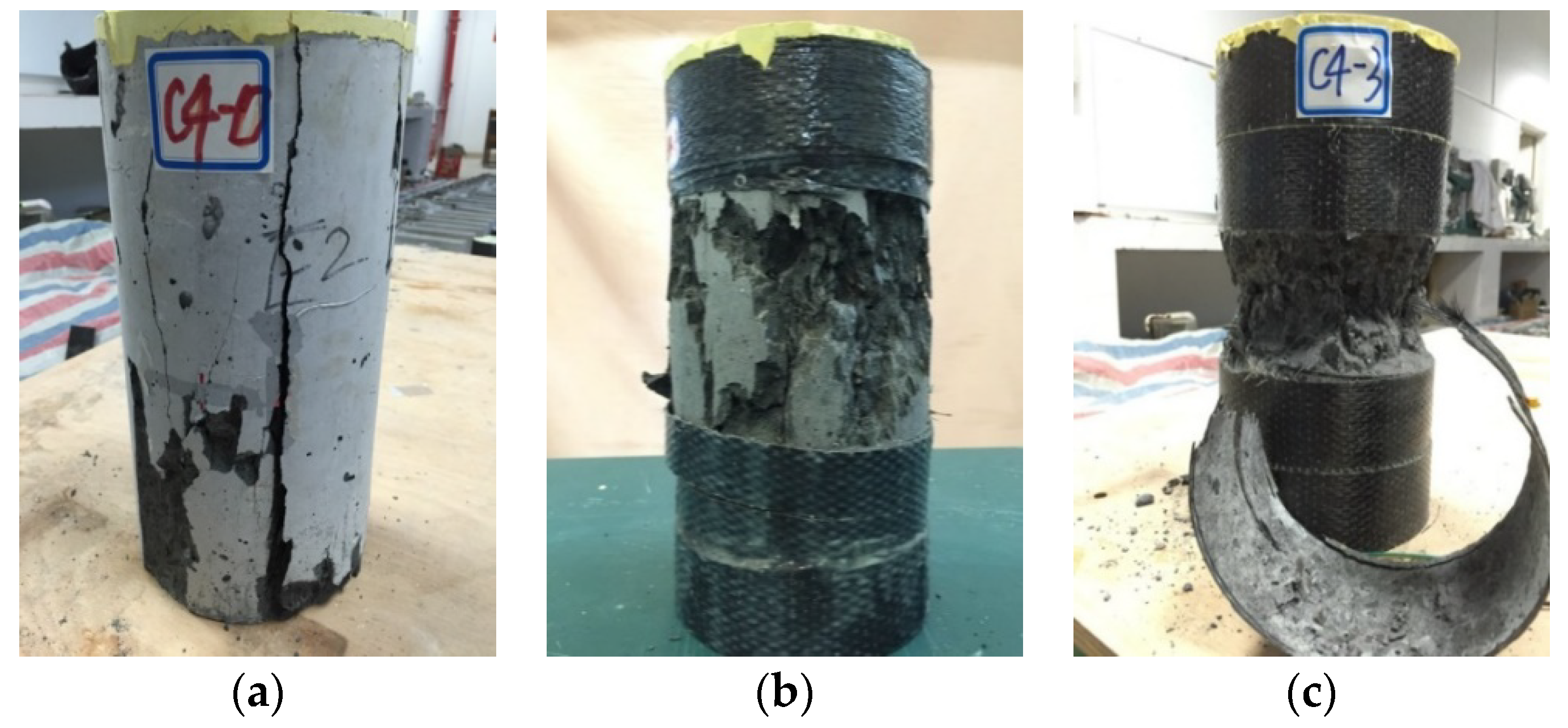
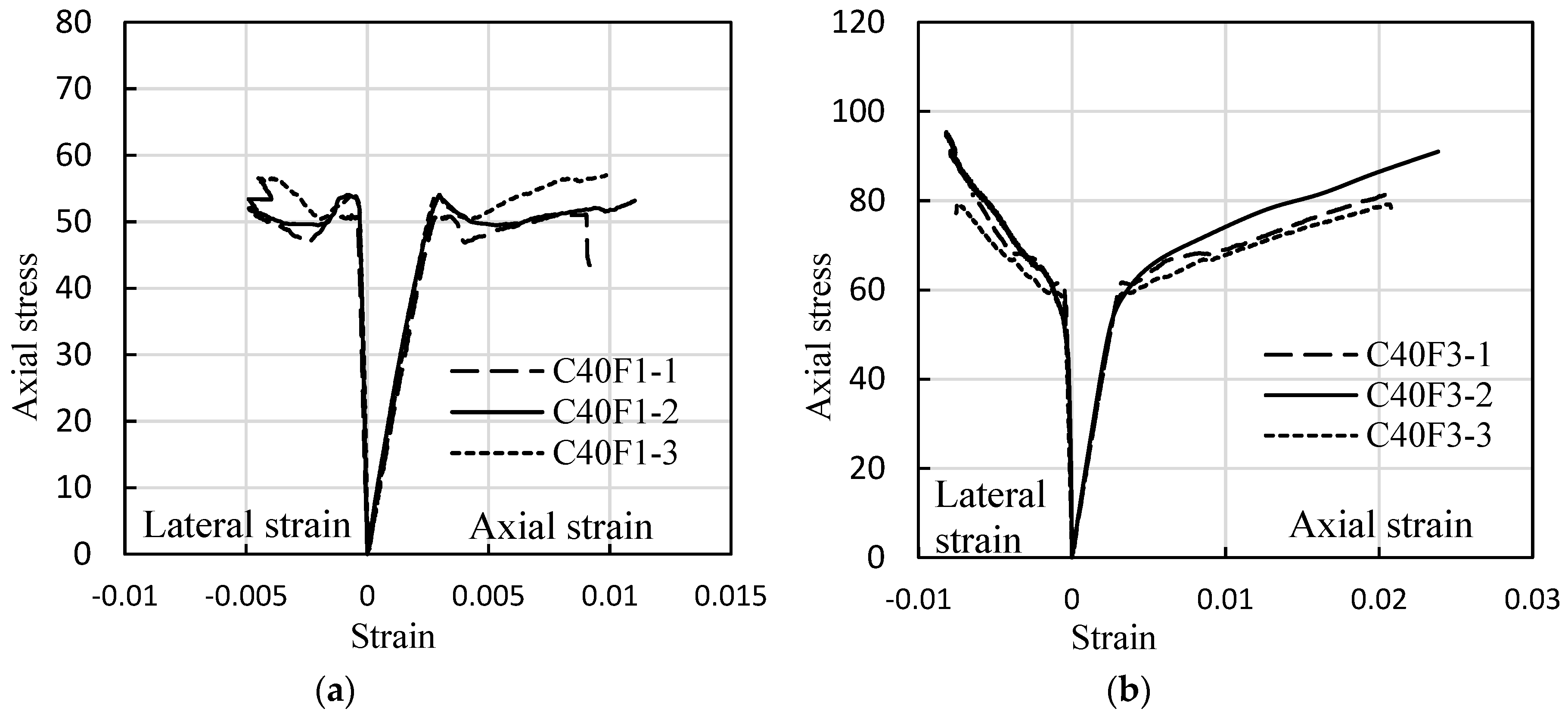
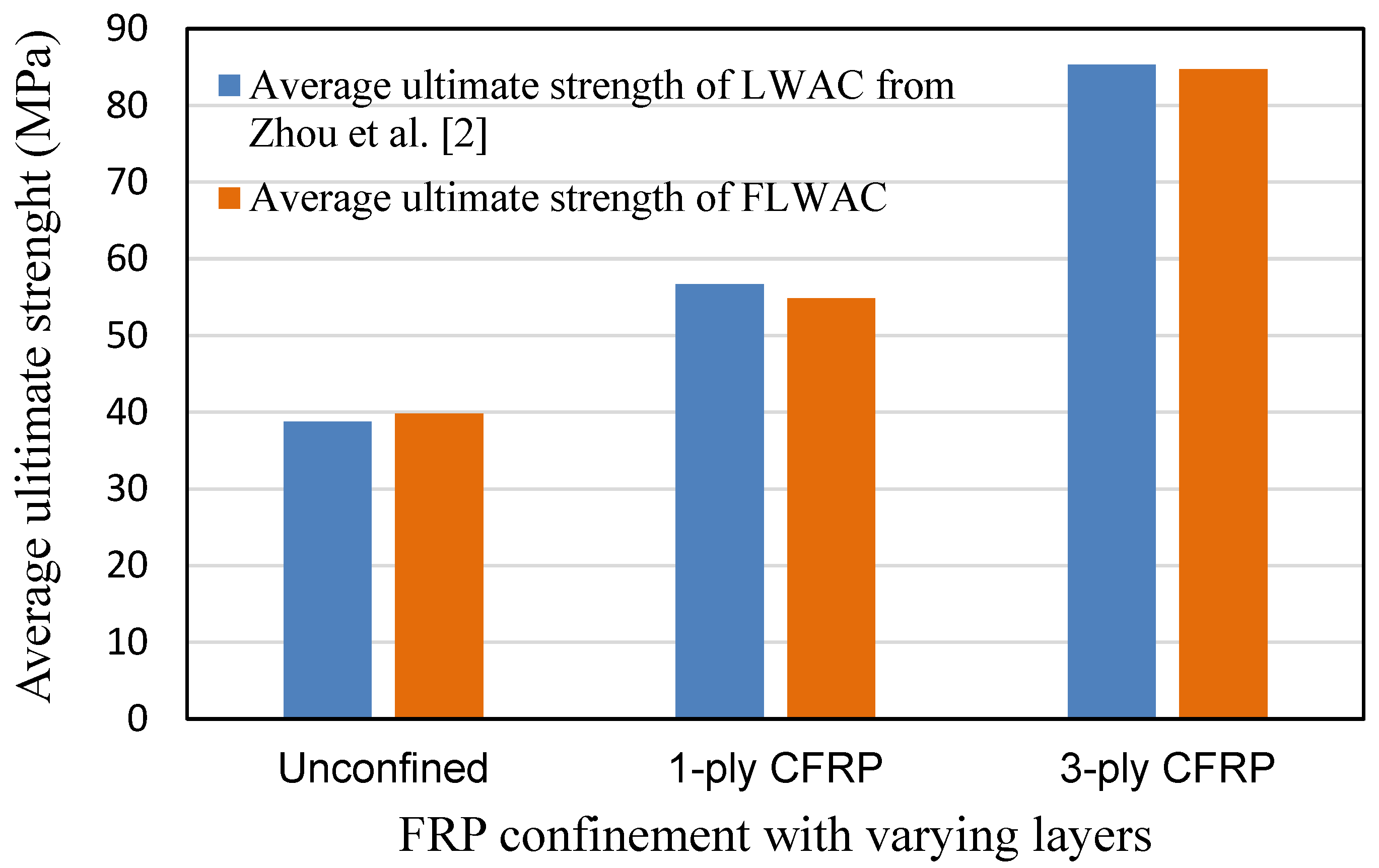

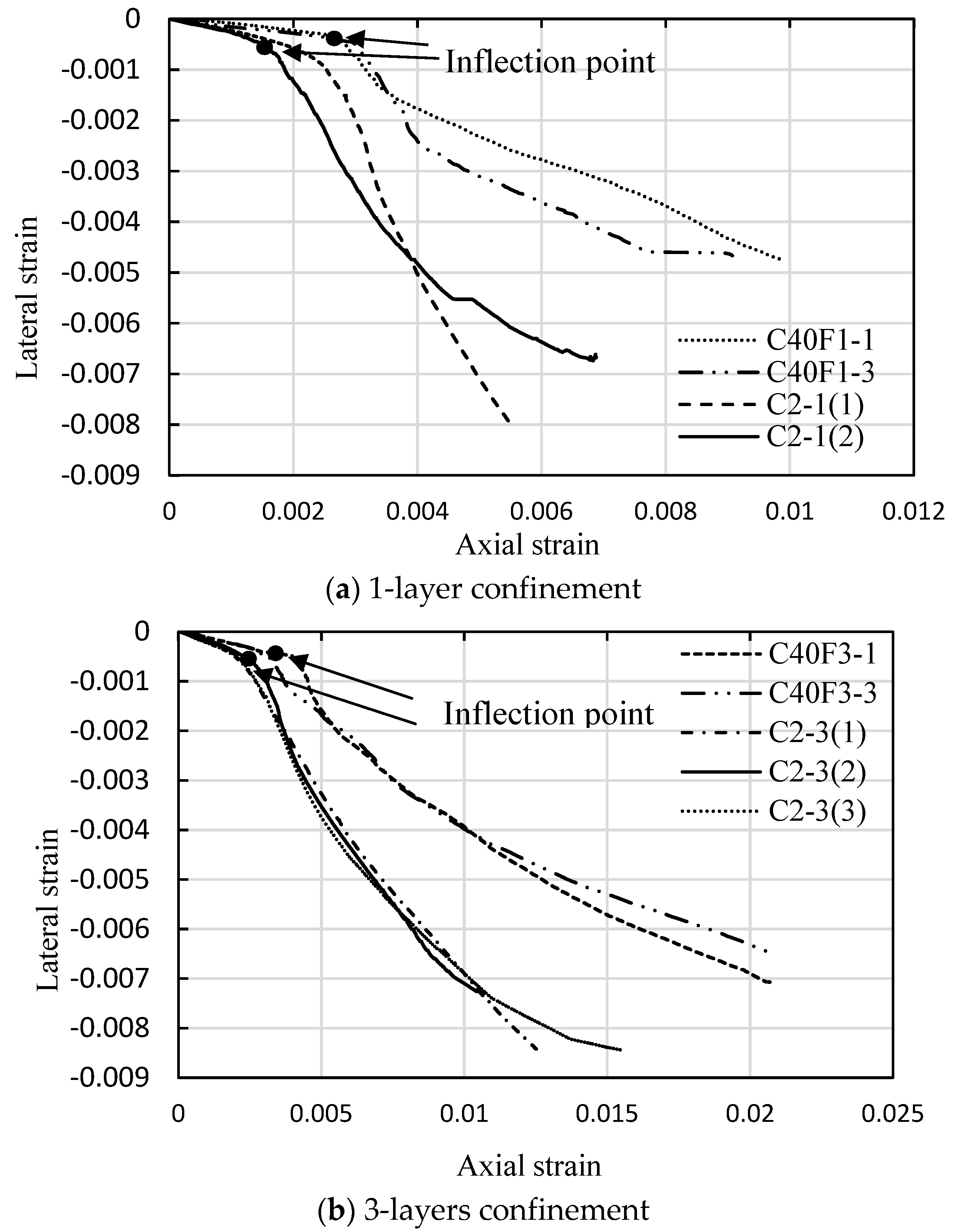


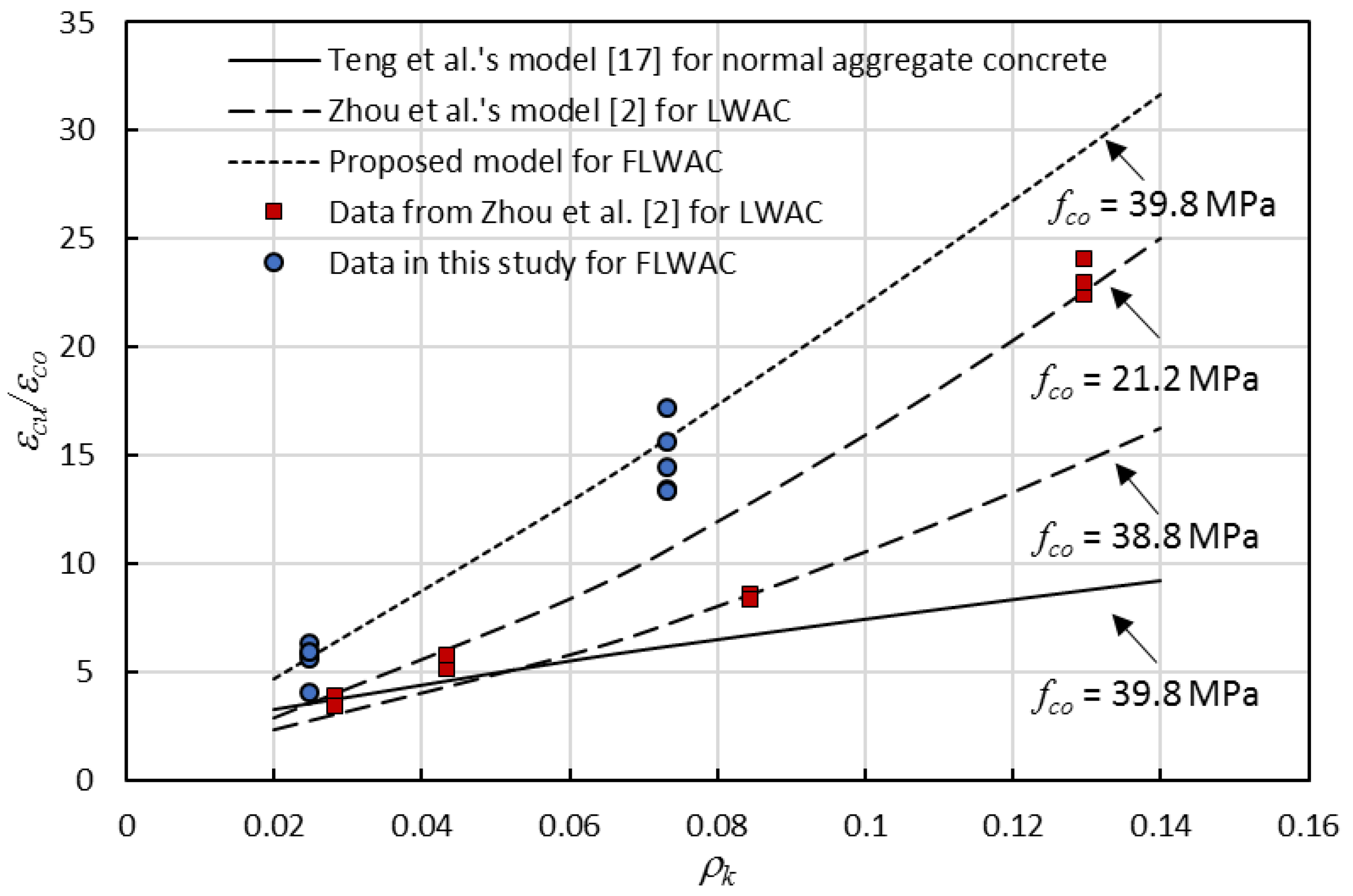



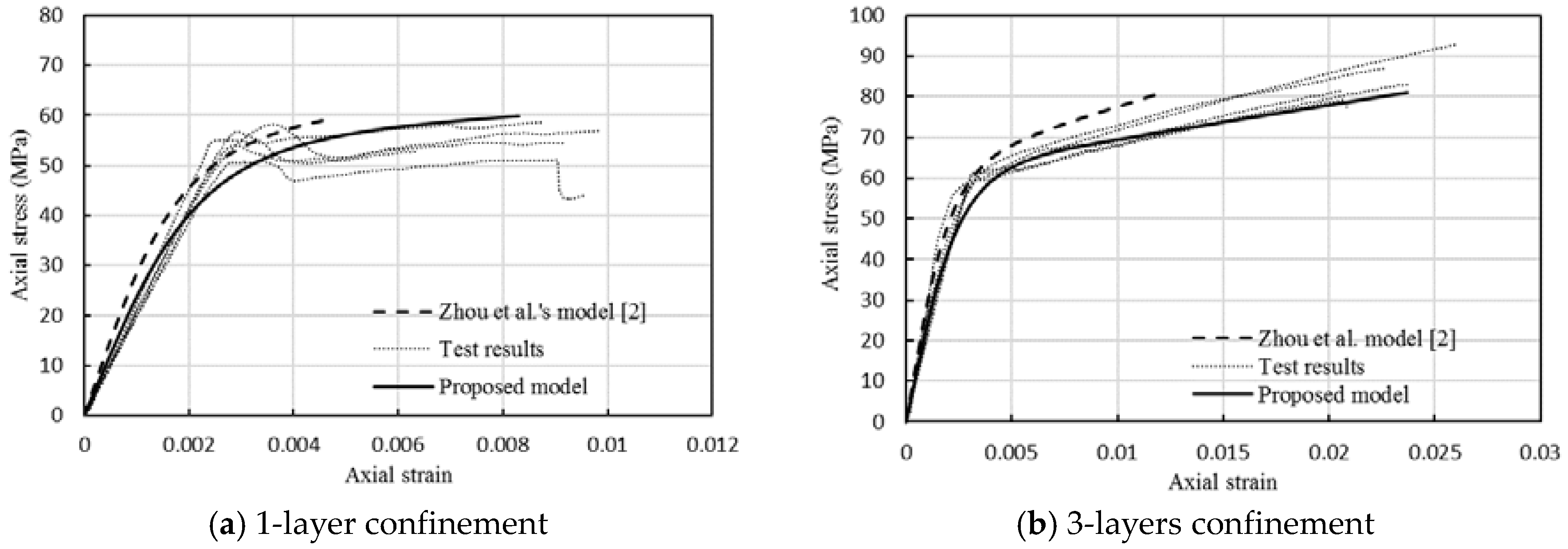
| Specimen NO. | fco (MPa) | fcom (MPa) | fcc (MPa) | FRP Layers | εco (%) | εcom (%) | εcu (%) | εhoop (%) | ks |
|---|---|---|---|---|---|---|---|---|---|
| New test data | |||||||||
| C40F0-1 | 37.1 | 39.8 | / | 0 | 0.188 | 0.151 | / | / | / |
| C40F0-2 | 40.9 | / | 0 | 0.132 | / | / | / | ||
| C40F0-3 | 41.4 | / | 0 | 0.136 | / | / | / | ||
| C40F1-1 | / | / | 51.0 | 1 | / | / | 0.903 | 0.566 | 0.460 |
| C40F1-2 | / | 52.7 | 1 | / | 0.632a | 0.502 | 0.408 a | ||
| C40F1-3 | / | 57.0 | 1 | / | 0.985 | 0.474 | 0.385 a | ||
| C40F1-4 | / | 58.6 | 1 | / | 0.872 | 0.561 | 0.456 | ||
| C40F1-5 | / | 54.4 | 1 | / | 0.919 | 0.571 | 0.464 | ||
| C40F3-1 | / | / | 81.4 | 3 | / | / | 2.058 | 0.648 | 0.527 |
| C40F3-2 | / | 83.2 | 3 | / | 2.384 | 0.899 | 0.730 | ||
| C40F3-3 | / | 79.2 | 3 | / | 2.047 | 0.732 | 0.595 | ||
| C40F3-4 | / | 93.0 | 3 | / | 2.616 | 0.572 | 0.465 | ||
| C40F3-5 | / | 86.8 | 3 | / | 2.207 | 0.600 | 0.488 | ||
| Zhou et al. [2] | |||||||||
| C1-1(1) | 21.2 | 34.5 | 1 | 0.151 | 0.780 | 0.717 | 0.463 | ||
| C1-1(2) | 38.2 | 1 | 0.875 | 0.418 | 0.270 a | ||||
| C1-1(3) | 49.9 | 1 | 1.003 | 0.598 | 0.398 | ||||
| C1-3(1) | 54.6 | 3 | 3.389 | 0.701 | 0.453 | ||||
| C1-3(2) | 52.8 | 3 | 3.475 | 0.769 | 0.496 | ||||
| C1-3(3) | 54.5 | 3 | 3.641 | 0.787 | 0.508 | ||||
| C2-1(1) | 57.2 | 1 | 0.708 | 0.756 | 0.488 | ||||
| C2-1(2) | 38.8 | 56.2 | 1 | 0.180 | 0.631 | 0.814 | 0.526 | ||
| C2-1(3) | 56.7 | 1 | 3.332 a | 0.655 | 0.439 a | ||||
| C2-3(1) | 85.5 | 3 | 1.506 | 0.805 | 0.520 | ||||
| C2-3(2) | 87.1 | 3 | 1.559 | 0.814 | 0.526 | ||||
| C2-3(3) | 83.4 | 3 | 1.516 | 0.885 | 0.571 | ||||
| Water kg/m3 | Cement kg/m3 | Coarse Aggregate kg/m3 | Sand kg/m3 | Silica Fume kg/m3 | Water to Cement Ratio | Dry Density kg/m3 | fco MPa | εco% | Ec GPa |
|---|---|---|---|---|---|---|---|---|---|
| 150 | 450 | 477 | 405 | 50 | 0.30 | 1581 | 39.8 | 0.151 | 22.0 |
| Coarse Aggregate Type | 24 h Water Absorption (%) | Bulk Density (kg/m3) | Apparent Density (kg/m3) | Tube Crushing Strength (MPa) |
|---|---|---|---|---|
| Class 800 crushed shale ceramsite | 6.0 | 750 | 1272 | 6.4 |
| Nominal Grain Size/mm | 19 | 16 | 9.5 | 4.75 | 2.36 | <2.36 |
|---|---|---|---|---|---|---|
| screen residue (g) | 133.3 | 730.4 | 3215.6 | 3552.9 | 353.7 | 167.0 |
| cumulative screen residue (%) | 1.6 | 10.6 | 50.1 | 93.6 | 97.7 | 100 |
| Nominal Grain Size/mm | 2.5 | 1.25 | 0.63 | 0.315 | 0.16 | <0.16 |
|---|---|---|---|---|---|---|
| screen residue (g) | 8.8 | 558.8 | 159.5 | 48.8 | 5.0 | 21.8 |
| cumulative screen residue (%) | 1.1 | 70.8 | 90.6 | 96.7 | 97.3 | 100 |
© 2018 by the authors. Licensee MDPI, Basel, Switzerland. This article is an open access article distributed under the terms and conditions of the Creative Commons Attribution (CC BY) license (http://creativecommons.org/licenses/by/4.0/).
Share and Cite
Li, P.; Sui, L.; Xing, F.; Huang, X.; Zhou, Y.; Yun, Y. Effects of Aggregate Types on the Stress-Strain Behavior of Fiber Reinforced Polymer (FRP)-Confined Lightweight Concrete. Sensors 2018, 18, 3525. https://doi.org/10.3390/s18103525
Li P, Sui L, Xing F, Huang X, Zhou Y, Yun Y. Effects of Aggregate Types on the Stress-Strain Behavior of Fiber Reinforced Polymer (FRP)-Confined Lightweight Concrete. Sensors. 2018; 18(10):3525. https://doi.org/10.3390/s18103525
Chicago/Turabian StyleLi, Pengda, Lili Sui, Feng Xing, Xiaoxu Huang, Yingwu Zhou, and Yanchun Yun. 2018. "Effects of Aggregate Types on the Stress-Strain Behavior of Fiber Reinforced Polymer (FRP)-Confined Lightweight Concrete" Sensors 18, no. 10: 3525. https://doi.org/10.3390/s18103525





